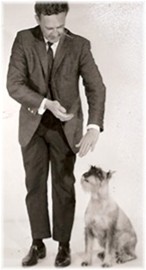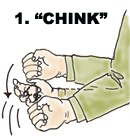|

KEYS TO SUCCESS
TIMING
Whether you're teaching DOs or DON'Ts, your
timing is critical to your success. Your timing is off if your
word is even a split second behind the sound.
SPEED
The DOG-MASTER® method is simple but incredibly
fast. As you progress you must speed up your technique, with
each call lasting for no more than one second.
PROPER HANDLING OF INSTRUMENTS
As discussed here in the middle section,
these instruments are not toys. Keep them silent as much as
possible. The sound should only be "heard"
by the dog during teaching, or when correcting problems.
Otherwise it may only create confusion.
MAINTENANCE
Wash and clean all the instruments with warm water and
soap or detergent after every use. Dirt and grime may start
affecting the sound if the instruments are not properly
maintained.
|
|
 is
FUN and EASY! The sound controls your dog’s attention and carries his mind wherever
you want. Dr. Miller's patent is also a METHOD patent, so the
instruments and their proper use are co-existent, part of one cohesive system. We've
already presented the WHAT. Now we discuss the HOW. is
FUN and EASY! The sound controls your dog’s attention and carries his mind wherever
you want. Dr. Miller's patent is also a METHOD patent, so the
instruments and their proper use are co-existent, part of one cohesive system. We've
already presented the WHAT. Now we discuss the HOW.
The DOs and the DON'Ts
The DOG-MASTER® method is really very simple. The technique is
categorized into 2 groups: the DOs, and the DON'Ts. Both techniques
involve sounding the DOG-MASTER® instrument at the right time, but there
are major differences in the steps.
The DOs: As the term
implies, DOs are things you want your dog to do, like COME, SIT, STAY,
HEEL, FETCH, GUARD, RETRIEVE. The amount of words your dog can learn is
really limitless. Teaching DOs requires the owner to call the dog's name
and to speak the command at the exact same time the instrument is
sounded at the dog.
The DON'Ts:
Did your dog soil up your velvet drapes? Obviously, that's a DON'T. DON'Ts
are all things you want to teach your dog NOT to do. It is all about
problem correction.
Unlike the DO technique, DON'Ts are taught without speaking. In fact, it
is vital to NOT speak at all as speaking draws the dog's attention to
you instead of the correction. They are really easier to teach than DOs.
See examples here.
äNOTEä
No matter how much you want to correct your dog's behavior right away,
DON'Ts are best taught AFTER teaching COME, because your vital
Master-image must first be established, or your dog will never take
other directions well.

YOUR GOAL: ESTABLISH YOUR MASTER IMAGE
The dog in the picture to the right is so "tuned in" to Dr. Miller.
He sees Dr. Miller as leader, protector and master. Your own success
looms large when your dog sees you as teacher, protector, and leader of
the pack. That is your goal.
THE WAY TO BECOMING MASTER
First, you teach "COME."
COME indoctrinates your dog. COME is the only word-command where your
dog is to respond to YOU, and becomes tuned in to YOU alone. COME makes
you seem ten feet tall to your dog. Other commands are made for your dog
to respond elsewhere, like Sit, Stay, Fetch, Point, etc. When your dog
comes to you instantly at all times, all other commands and problem
corrections become a breeze.
"SOUND" THE INSTRUMENT PROPERLY
Before you teach COME, you must first know how to handle the
instruments properly. Keep in mind that they are NOT toys; they
are precision-made to produce a very sensitive sound. Any small movement
will cause the tuning fork to vibrate. So, try not to dangle or jiggle
it. Keep it "silent" until the right time comes.
There are 2 ways to produce this learning sound:
- Hold it in your palm and give it one quick shake— a
“chink” as we call it. Just one chink. That’s all you need.
- Flick or toss the
instrument toward the direction of your dog, where the sound can reach
him. It sounds as it lands.
 
Now, fix in your own mind that, where the
sound is made to occur, that is where the dog's mind and total attention
will be drawn to.
-
Sounded in your hand where you are, the dog's
attention is instantly on you.
-
Sounded right at your dog at the exact same time
and instant as your voiced command, your dog understands that you have
reached him/her from a distance with a word.
In moments, you've acted out a new concept to
your dogš
COMMUNICATION!
<< THE BASICS OF TEACHING "COME!" >>
Back to top
Copyright©2011-2012 All Rights Reserved
DOG-MASTER LEARNING SYSTEM |

The Theory: PAVLOV'S BELL
 The DOG-MASTER® instruments are a highly advanced evolvement of
the principles behind Pavlov’s (1849-1936) famous bell and
conditioning experiments. Pavlov chose a bell because a dog’s hearing is
his keenest learning sense, far faster than pain. Pavlov’s research
established that the particular nature of canine reflexes allows a dog
to be more easily conditioned to create new or more desirable responses.
And once conditioned, to involve more of his mind and mental abilities
resulting in a greatly expanded thinking and understanding dog. The DOG-MASTER® instruments are a highly advanced evolvement of
the principles behind Pavlov’s (1849-1936) famous bell and
conditioning experiments. Pavlov chose a bell because a dog’s hearing is
his keenest learning sense, far faster than pain. Pavlov’s research
established that the particular nature of canine reflexes allows a dog
to be more easily conditioned to create new or more desirable responses.
And once conditioned, to involve more of his mind and mental abilities
resulting in a greatly expanded thinking and understanding dog.
NO SOUND IN A VACUUM
 This
is a picture of Robert Boyle's jar, the 17th century experiment
that proved that a bell rung in a vacuum could NOT BE HEARD, due
to lack of any atmosphere to carry the sound. This
is a picture of Robert Boyle's jar, the 17th century experiment
that proved that a bell rung in a vacuum could NOT BE HEARD, due
to lack of any atmosphere to carry the sound.
The same is true
for the DOG-MASTER sound― the heavier the atmosphere
(meaning the higher the humidity), the better any sound is
carried.
|
THE DOPLER EFFECT

When a person or a dog moves rapidly away
from the source of a sound, he hears the sound as changed to a
lower pitch. Conversely, if moving rapidly towards the source,
he hears a higher pitch. The M-3 and the M-4 instruments
successfully counteract this phenomenon.
|
|

